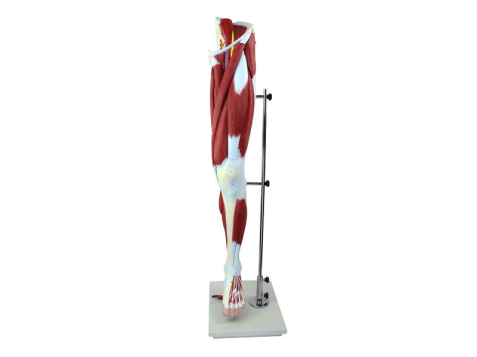

Article tag: Lower limb muscle model| muscle anatomy model|
The lower limb muscle model plays an indispensable role in medical education and physical therapy training, providing an intuitive and three-dimensional learning tool for learners and trainers. Here ar...
The lower limb muscle model plays an indispensable role in medical education and physical therapy training, providing an intuitive and three-dimensional learning tool for learners and trainers. Here are some specific ways lower limb muscle models can help in both areas:

Medical education
1. Gain a deep understanding of muscle structure
Through the three-dimensional display of the lower limb muscle model, medical students can clearly see the shape, position, starting point and stopping point of the muscle. This intuitive learning method helps students to have a deeper understanding of the structure of lower limb muscles, and lays a solid foundation for the subsequent study of kinematics, anatomy and other related courses.
2. Improve memory
Compared with the traditional text description and two-dimensional pictures, the lower limb muscle model can attract students' attention more and stimulate their interest in learning. Students can deepen the memory of muscle structure and improve the learning effect through touch, observation and practice.
3. Cultivate clinical operation ability
In medical education, students not only need to master theoretical knowledge, but also need to have certain clinical operation ability. The lower limb muscle model can simulate the real clinical environment, allowing students to perform practical operations on the model, such as muscle positioning, puncture, injection, etc., so as to improve students' clinical operation ability.
Physical therapy training
1. Accurately assess muscle function
The physical therapist needs to evaluate the muscle function of the patient during treatment. The lower limb muscle model can help physiotherapists to familiarize and identify various muscles, so as to more accurately evaluate the muscle function status of patients and provide basis for the formulation of treatment plans.
2. Develop a personalized treatment plan
Based on an accurate assessment of the patient's muscle function, the physical therapist can use the lower limb muscle model to develop a personalized treatment plan. By simulating different muscle injury and dysfunction conditions, physical therapists can test different treatments to provide the most appropriate treatment plan for the patient.
3. Improve treatment effect
During physical therapy, patients undergo a series of rehabilitation exercises to restore muscle function. The lower limb muscle model can help physiotherapists guide patients to correct rehabilitation training movements and avoid secondary injury to patients caused by wrong postures and movements. At the same time, the model can also simulate different muscle tension and strength levels, helping patients gradually increase the difficulty of training and improve the treatment effect.
To sum up, the lower limb muscle model plays an important role in medical education and physical therapy training, providing learners and trainers with intuitive and three-dimensional learning tools and practice platforms.